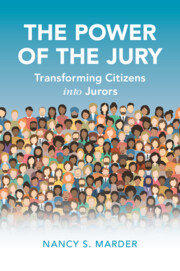28 results
Contents
-
- Book:
- The Power of the Jury
- Published online:
- 25 August 2022
- Print publication:
- 15 September 2022, pp v-v
-
- Chapter
- Export citation
4 - Jury Instructions: Reinforcing Group Identity and Making Instructions Accessible to Jurors
-
- Book:
- The Power of the Jury
- Published online:
- 25 August 2022
- Print publication:
- 15 September 2022, pp 113-148
-
- Chapter
- Export citation
6 - The Post-Verdict Interview: How Judges Can Help Jurors in Their Transformation from Jurors into Engaged Citizens
-
- Book:
- The Power of the Jury
- Published online:
- 25 August 2022
- Print publication:
- 15 September 2022, pp 209-243
-
- Chapter
- Export citation
Index
-
- Book:
- The Power of the Jury
- Published online:
- 25 August 2022
- Print publication:
- 15 September 2022, pp 258-266
-
- Chapter
- Export citation
3 - Peremptory Challenges: A Barrier That Unnecessarily Limits Who Can Serve as Jurors
-
- Book:
- The Power of the Jury
- Published online:
- 25 August 2022
- Print publication:
- 15 September 2022, pp 76-112
-
- Chapter
- Export citation
1 - The Summons and the Setting: Beginning the Transformation of Citizens into Jurors
-
- Book:
- The Power of the Jury
- Published online:
- 25 August 2022
- Print publication:
- 15 September 2022, pp 13-40
-
- Chapter
- Export citation
Conclusion
-
- Book:
- The Power of the Jury
- Published online:
- 25 August 2022
- Print publication:
- 15 September 2022, pp 244-257
-
- Chapter
- Export citation
Acknowledgments
-
- Book:
- The Power of the Jury
- Published online:
- 25 August 2022
- Print publication:
- 15 September 2022, pp vi-x
-
- Chapter
- Export citation
5 - Jury Deliberations: Performing the Jury’s Main Task with Some Assistance from the Judge
-
- Book:
- The Power of the Jury
- Published online:
- 25 August 2022
- Print publication:
- 15 September 2022, pp 149-208
-
- Chapter
- Export citation
2 - Voir Dire: Introducing Jurors to the Judge, Their Fellow Jurors, and Their Role
-
- Book:
- The Power of the Jury
- Published online:
- 25 August 2022
- Print publication:
- 15 September 2022, pp 41-75
-
- Chapter
- Export citation
Introduction
-
- Book:
- The Power of the Jury
- Published online:
- 25 August 2022
- Print publication:
- 15 September 2022, pp 1-12
-
- Chapter
- Export citation
Copyright page
-
- Book:
- The Power of the Jury
- Published online:
- 25 August 2022
- Print publication:
- 15 September 2022, pp iv-iv
-
- Chapter
- Export citation

The Power of the Jury
- Transforming Citizens into Jurors
-
- Published online:
- 25 August 2022
- Print publication:
- 15 September 2022
1 - Introduction
-
-
- Book:
- Juries, Lay Judges, and Mixed Courts
- Published online:
- 03 August 2021
- Print publication:
- 29 July 2021, pp 1-22
-
- Chapter
- Export citation
Contents
-
- Book:
- Juries, Lay Judges, and Mixed Courts
- Published online:
- 03 August 2021
- Print publication:
- 29 July 2021, pp v-vi
-
- Chapter
- Export citation
Name Index
-
- Book:
- Juries, Lay Judges, and Mixed Courts
- Published online:
- 03 August 2021
- Print publication:
- 29 July 2021, pp 346-353
-
- Chapter
- Export citation
Part II - Enduring Systems of Lay Participation
-
- Book:
- Juries, Lay Judges, and Mixed Courts
- Published online:
- 03 August 2021
- Print publication:
- 29 July 2021, pp 129-194
-
- Chapter
- Export citation
Part IV - Global Perspectives on Lay Participation
-
- Book:
- Juries, Lay Judges, and Mixed Courts
- Published online:
- 03 August 2021
- Print publication:
- 29 July 2021, pp 283-345
-
- Chapter
- Export citation
Part III - Challenges to Lay Participation in Law
-
- Book:
- Juries, Lay Judges, and Mixed Courts
- Published online:
- 03 August 2021
- Print publication:
- 29 July 2021, pp 195-282
-
- Chapter
- Export citation
Copyright page
-
- Book:
- Juries, Lay Judges, and Mixed Courts
- Published online:
- 03 August 2021
- Print publication:
- 29 July 2021, pp iv-iv
-
- Chapter
- Export citation



